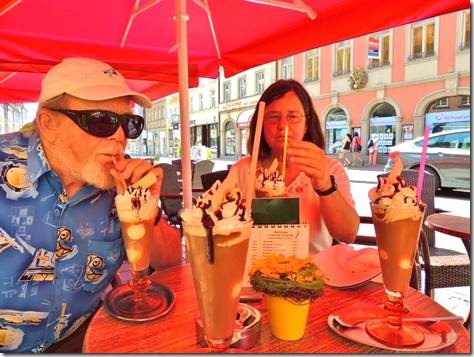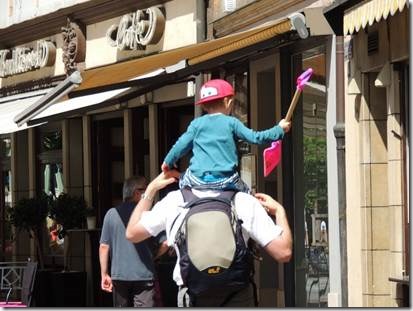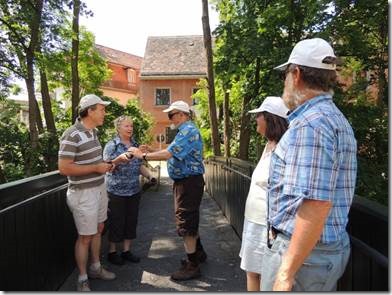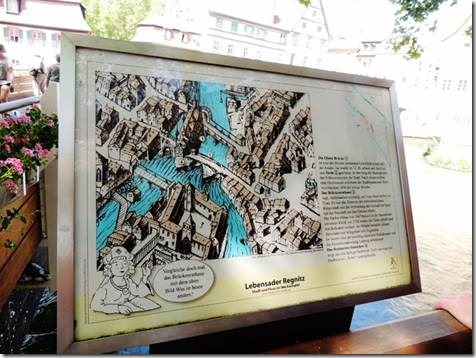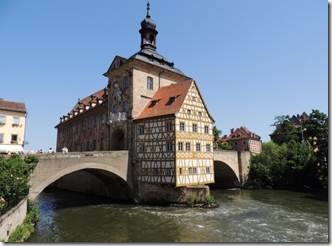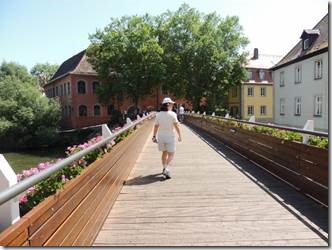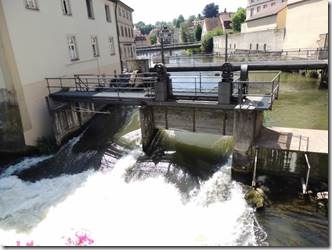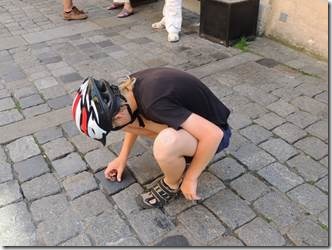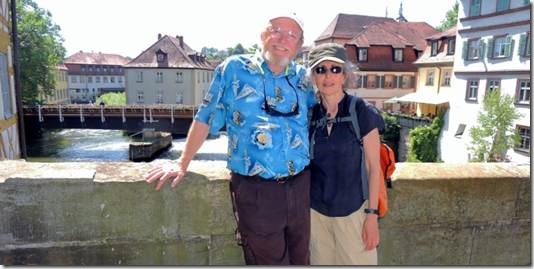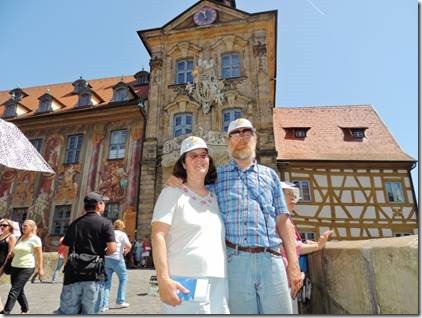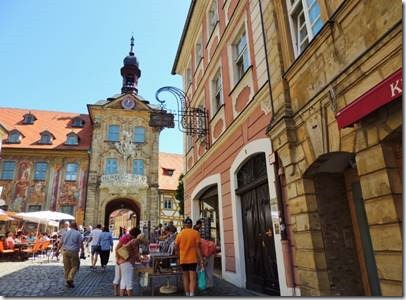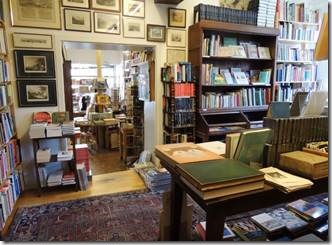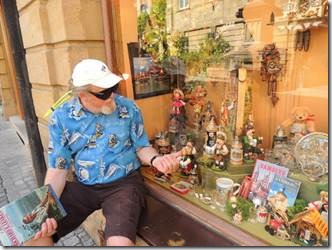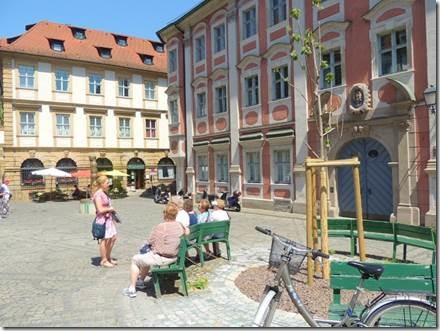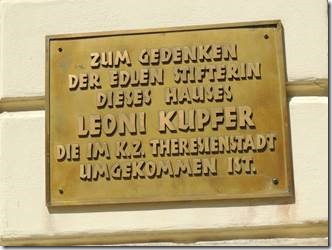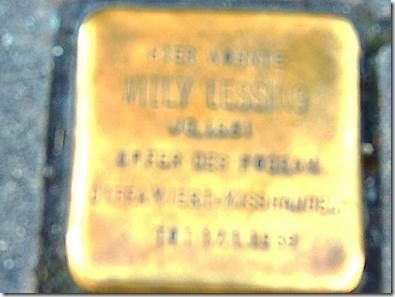Motor Yacht Club of Nuremberg
Guten Tag,
We went through some monster locks to get from Bamberg to Nuremberg. They were 18 meters and tomorrow’s will be 24.7 so we are really climbing. At one point the canal was built over a highway.
At some point I’ll write about it all. This email is about our visit to Bamberg. We took the bus a half mile or so from the marina to the terminal in Bamberg. It was really hot late morning when we arrived. We stayed in Bamberg until about 4 pm and then caught the bus back, finally trudging back to DoraMac in the late afternoon heat. There’s so much to see in Bamberg. We wandered around until we just ran out of energy.
Ru
“From the 10th century onwards, this town became an important link with the Slav peoples, especially those of Poland and Pomerania. During its period of greatest prosperity, from the 12th century onwards, the architecture of Bamberg strongly influenced northern Germany and Hungary. In the late 18th century it was the centre of the Enlightenment in southern Germany, with eminent philosophers and writers such as Hegel and Hoffmann living there.
The street layouts of the three historic core areas retain their medieval features. The many historic buildings in these areas are authentic. Since the 1950s Bamberg has undergone a continuous programme of restoration of its historic properties and areas. This programme proceeded by a series of small projects (the “Bamberg model”) rather than by large and ambitious schemes resulting in the uniformly high level of conservation of Bamberg.”
http://whc.unesco.org/en/list/624
|
Our first Bamberg stop was “iced coffee.” I was wondering how they made the vanilla ice for the “iced coffee” so it was a surprise that vanilla ice was actually vanilla ice cream. |
|
A happy family scene |
|
He took a photo of her and she took a photo of him, so Randal offered to take a photo of both. Meeting a German couple from Stuttgart; he had who had worked in Chester VA along route 128 in Boston, MA. |
|
A map of the Old Town Hall. The back side of the Old Town Hall According to the Bamberg brochure, the Bishop wouldn’t give up any of his land to the citizens for a town hall so they built it in the river. The Old Town Hall, sometimes called the Bridge Town Hall or Island Town Hall, built in the middle of the Regnitz as a border between the civil and ecclesiastical centers of Bamberg on neutral “ground”, connected with the upper and lower bridge. Architecture and location demonstrates one of the most original Town Halls of Germany. First mentioned 1386, The Tower and Town Hall were destroyed by a gunpowder explosion in 1440. Rebuilt from 1450-1463. The facade is decorated with frescoes paintings. http://bambergerbahnen.de/index.php/en/sights-of-bamberg/upper-bridge Walking along one of the many Bamberg bridges. Controlling the water flow. Old part of town The predominantly undamaged city center, with over 2,000 protected historical buildings and monuments on approximately 250 hectares of land, makes Bamberg one of the largest, interconnected medieval cities of Europe. The "Bamburger Weg" , an established model for preservation and refurbishment of the city, with co-operation from other cities concerned with the preservation of historical monuments (Regensburg, Lübeck, Stralsund, Görlitz, Meißen) and multiple means of building preservation, won the city high-ranking acknowledgement. In 1993 the city of Bamburg was admitted into the UNESCO list of "world culture and nature heritage of mankind." A bridge was already leading across the river in the early 11th century. The original town hall, dating from the middle 14th century, was reconstructed by the inhabitants after a catastrophical fire in 1440. Michael Küchel redesigned the town hall (between 1744 to 1756) in Baroque/Rococo Style. Not only the wonderful architecture captivates, but particularly the frescos, with their 3-dimentional vitality. |
|
Some copper and silver coins had been embeded in the road and some of the children were trying unsuccessfully to pick them out. |
|
Posing on the bridge |
|
Mary and Rick |
|
Looking back towards the Town Hall |
|
A very beautiful book shop just near the bridge with wood floors and Oriental carpets. |
|
Shops were closed for the Monday holiday. |
|
Judenstrasse This local guide, speaking English, was telling her tour group about the history of the Jews in Bamberg. A memorial to Keoni Kupfer who died at Theresienstadt Willy Lessing’s stumbling stone not far from the bus terminal I had read about his family’s brewery so it was like meeting someone I had known. http://www.franconiabeerguide.com/hofbraeu.asp tells the entire story. “When the Nazi’s came to power Bamberg was not spared the horrors the rest of Germany experienced. The Jewish community in Bamberg was one of the oldest in Bavaria. Starting in 1934 the Nazi’s forced many Jewish stockholders to sell their holdings at fire sale prices. In 1936 the Nazi’s appropriated the shares of Hofbräu AG owned by Willy Lessing . Around this time his wife and son left Germany for England (his son, Fred Lessing, later lived in New York City.) Willy stayed in Bamberg. In the evening of November 9th, 1938 ("Kristalnacht") the Bamberg Synagogue was set on fire by the mob. At 2am Willy Lessing came down to the Synagogue and implored the fire department to put out the fire (They did not put out the fire but stood by to make sure the fire didn’t spread to nearby buildings.). A gang of Hitler Youth then beat Willy severely. At this time Jews were not allowed into the local hospital but the Archbishop of Bamberg was able to bring pressure to bear and WIlly was admitted. However, he died of his injuries two months later on January 17, 1939, two days before his 58th birthday. After the Second World War, in 1946, one of the arsonists was sentenced to two years in prison and one of Willy’s assailants was sentenced to four years in prison. Two others were identified, but not tried. Two years later in 1948 the Bamberg City Council renamed Sophienstrasse, the street where Simon Lessing had his hop brokerage and both generations of Lessings lived, to Willy-Lessing-Strasse. (For those of you familiar with Bamberg, this is the street from the Luitpold Bridge over the Regnitz towards the Altstadt). Fred Lessing appears to have received some compensation, but the he was no longer involved in the brewery. His mother (Willy’s wife) had died in London in 1944.” http://www.jewishencyclopedia.com/articles/2422-bamberg http://en.bamberg.info/ Levi Strauss’s family came from Buttenheim just near Bamberg. Bamberg opened a museum in what had been the Strauss family homein Buttenheim in 2000. It is dedicated to the family and all things ‘jeans.’ |

